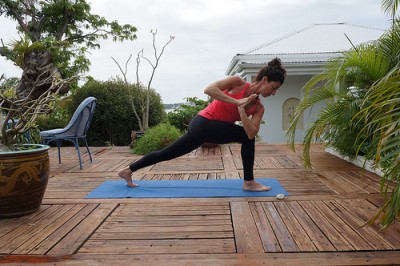
One of the things I love to do with themes for teaching is walk in with a theme in my head and challenge myself to create the sequence as the class progresses. I’ve found that if you start with an anatomical theme, like today’s theme, sidebending, and you have some experience teaching, you can create variations of poses that will reinforce this movement. One of the best teachers doing this today is Tiffany Cruikshank and I’d be remiss in not mentioning her as the inspiration for my approach.
The other reason I love using this approach is that it gives me an opportunity to speak a little at the start of class about the musculature that supports this movement. In the case of sidebending, we’re talking about the quadratus lumborum muscle in the lower back (it runs from the lower border of the last rib and lumbar vertebra 1-4 and attaches to the iliac crest, or the top rim of the pelvic bone). If you stand and lean to one side, you’re contracting the muscle on the shortened side and lengthening it on the stretched side.
I love using this theme because many people naturally, or because of activities of daily living, lean more to one side or the other. This can create an imbalance in the pelvis and the shoulders that can translate into back pain, shoulder or neck pain. Also, if the pelvis is imbalanced, it can create changes in gait, especially when running. Some people have a clinical reason for a shift in their pelvis. It could be a leg length discrepancy or scoliosis. For these students, working side bending can create a bit more leveling of the pelvis and some natural correction. I am always amazed when I work with someone like this at how just warming the muscles and moving them in various ways creates incredible malleability in the body. One might start the practice uneven but only after an hour’s work, you can see more balance.
To use this theme in class, I like to start people in a seated position. I have them close their eyes and tap into the feeling of grounding into their sitting bones. From here, I speak to noticing the position of the pelvis, noticing if it’s level; the shoulders and their position and just a sense of rooting into the seat to lift straight up through the spine to the crown of the head. We then sweep one arm over the head and sidebend and switch to the other side. From there, we work through a few Sun Salutations to create stretch in the front and back of the body and to work length. From there, I add in poses like Warrior 2 and Side Angle, which has a natural sidebending shape to it. Variations on Half Moon and Plank include sweeping the top arm up and over the head. This creates the side bend in these poses, as they are traditionally more “straight line” postures. In poses like Crescent Lunge, we add a sidebend, which can be a great challenge to balance and when we get to the floor, we work twists in core work (the obliques are important sidebending muscles too, from more of a twisting perspective). Final seated poses include Revolved Head to Knee pose, which reinforces what we did at the start: rooting into the seat to extend and bend the spine.
This is just one sequence; the challenge for us as teachers is to think of different ways we can blend this action into a number of positions. One other nice variation is on Triangle: instead of straightening the front leg, keep it bent, as in Side Angle, and have students bring arms up and over the head, as if they were holding a beach ball above their head. This is hard to hold but strengthens the QL muscle.
I like to pick a theme at the beginning of the week and use it in the 3 different studios in which I teach. It allows me to switch up the poses and sequence a bit but it’s within the same “container” or theme. Have fun teaching!
